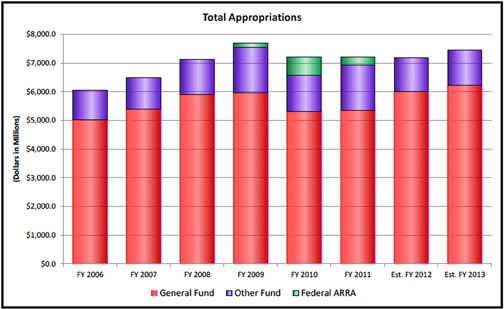Voting for the so-called “failed stimulus” has become a stock phrase in Republican attack ads against Congressional Democrats. But as Bleeding Heartland has discussed many times before, the “Great Recession” would have been more devastating without the 2009 American Recovery and Reinvestment Act.
State budget cuts are a huge drag on the economy. Follow me after the jump for a picture that’s worth a thousand words on how a favorite conservative punching bag helped soften the recession’s impact in Iowa.
Hat tip to the Iowa Policy Project for bringing this chart to my attention at the Iowa Policy Points blog, which I recommend bookmarking. The graphic below was Chart 1 in an August 24 report, Trends in General Fund Appropriations (pdf), from the non-partisan Legislative Services Agency’s Fiscal Services Division.
The red bars represent spending from the general fund, which is the largest share of the state budget. Under Iowa law, the state legislature cannot approve a budget with general fund spending that exceeds 99 percent of projected revenues for the next fiscal year.
The purple bars represent state spending from other funds. For example, state gasoline taxes go into the Road Use Tax Fund, which is earmarked for transportation spending. Gambling revenues go into the Rebuild Iowa Infrastructure Fund. In theory, the special funds are supposed to be used for specific programs, but legislators from both parties have long “raided” certain pots of money (such as the Iowa Comprehensive Petroleum Underground Storage Tank Fund) to support ongoing spending in other areas.
The green bars represent federal funding from the American Recovery and Reinvestment Act. Note that general fund spending dropped sharply from fiscal year 2009 to fiscal year 2010 and stayed at that low level for fiscal year 2011. While overall state expenditures declined from 2009 to 2010, the stimulus funds greatly softened the blow. Overall state expenditures for fiscal year 2011 stayed at roughly the same level, with a smaller boost from stimulus funds. By fiscal year 2012, state revenues had rebounded enough to keep overall spending stable again, this time without any federal stimulus support.
Iowa Policy Project Assistant Director Mike Owen commented,
One of the points we made at the Iowa Fiscal Partnership during and after the adoption of the Recovery Act was its use as a “bridge” for state services. As we note on our IFP [Iowa Fiscal Partnership] website, “economic stimulus measures need to be targeted, timely and temporary, to act as a bridge across the economic and fiscal valley of a recession.”
Recall that some in the Legislature, and some folks during the 2010 campaign season, complained that such use of “one-time funds” was a bad idea for ongoing services – that it would create a “cliff” in funding that, once exhausted, would leave the state on the hook for new responsibilities it might not be able to afford. […]
Clearly, the folks promoting one-time-fund orthodoxy were wrong, and the “bridge” analogy was spot-on.
The stimulus successfully bridged the gap in revenues to stop the critical loss of state services, and maintain the benefit of those services to the state’s economy.
The Iowa Fiscal Partnership is a collaboration between the Child & Family Policy Center and the Iowa Policy Project. This page on the partnership’s site contains much more data on the impact of the stimulus in Iowa. Andrew Cannon wrote in a February 2012 policy brief (pdf),
While there is certainly merit in reducing the use of one-time money for the continuing expenses of the state, one-time-fund critics sometimes let strict adherence to that concept get the best of them. For instance, Recovery Act dollars were used precisely as intended: targeted, timely and temporary relief so that states could continue funding critical services, such as K-12 education and health services to individuals and families. State revenues declined precipitously during the worst of the recession; the Recovery Act bridged that drop-off in revenues until a time when revenues improved as the economy regained strength. The same can be said for use of $38.7 million from one of the rainy-day funds since high unemployment and reduced revenues during the year must constitute the rainy revenue day that the fund was designed to cover.
No kidding. If you’re against dipping into your rainy-day fund during the worst U.S. recession since World War II, why bother to accumulate state reserves?
Iowa Republicans lied about so-called deficit spending when Chet Culver was governor and Democrats controlled both chambers of the state legislature. (I never saw a detailed Republican roadmap for balancing the state budget without using “one-time money” from the federal stimulus and state reserve funds.) Some GOP elected officials still fault Democrats for allegedly irresponsible budgeting, spending more money than state government takes in during any one year. But in the context of the Great Recession, making ends meet without American Recovery and Reinvestment Act funding would have been a disaster: more people without basic health care coverage through Medicaid, more teachers fired, more cuts to other school programs, fewer Iowans employed to fix roads and bridges.
The real failure of the stimulus was that it should have been larger and more targeted toward spending with the biggest “bang for the buck” in a weak economy.
On a related note, the chart posted above helps to illustrate why a federal constitutional amendment to require a balanced budget would be bad for the U.S. economy. Precisely when tax revenues fall at all levels of government, a balanced budget amendment would prevent the federal government from providing a bridge to protect key state services.
Take note, Congressional Republicans and scared Democrats who should know better.

